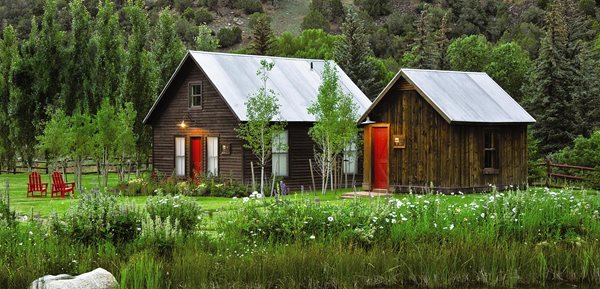2010's Best Residential Landscapes
From a record number of entries, Garden Design and the American Society of Landscape Architects picked the 14 best residential landscape designs. Take a look at a few of the winning gardens.

Photo by: Todd Richardson
For this rustic family retreat in the woods of Maine, landscape architect Todd Richardson created an "invisible-touch" landscape, blending the design almost imperceptibly into the site's existing rocky outcroppings, glades of ferns, and moss-covered boulders. The suspended footbridge of hemlock planks and steel cables was, as Richardon says, "surgically inserted" into the woods.

Photo by: Todd Richardson
Richardson continued his seamless blending of nature and design with a "natural spring" spa. To preserve the area's unity with the surrounding hillside, during construction Richardson wrapped the lichens and moss coating the boulders in burlap and kept them moist to protect and sustain them.

Photo by: Jim Bartsch
For the narrow lot of this beachfront home near Santa Barbara, landscape architect Keith LeBlanc created a tropical garden with a palette of materials that reflects the cool lines of the owner's modernist home. Bronzy phorumium kept low in a sunken bed surrounding the oceanfront terrace afford unbroken sunset views.

Photo by: Jim Bartsch
For the home's central courtyard, LeBlanc broke up the expanse of concrete, recycling it into a smaller walkway of pavers. Phormium and Papyrus planted in front of a translucent glass privacy fence cast ever-changing shadows for a touch of drama.

Photo by: Michael Moran
Landscape architect Johnathan Farber created this garden to showcase the contemporary home and midcentury modern sculpture collection of homeowner and noted architect, Lee Mindel. With native Amelanchier trees, simple native grasses, and subtle gravel and low stone walls, the bold architecture of the home and the striking outdoor art take center stage.

Photo by: Keith LeBlanc
Landscape architect Keith LeBlanc's garden design for his own private Cape Cod includes traditional New England materials like bluestone and wood shingles. With these materials, dependable native plants like witch hazels and dwarf fothergilla and regionally popular blooms such as hydrangeas and allium, the retreat retains a distinctive sense of place.

Photo by: Gisela Borghi
For this former electrical substation converted to a residence, landscape designer David Hocker employed strong geometric patterns and industrial materials that recall the site's history. Combined with a simple palate of plants, including buffalo grass that needs mowing only once a year and a lone multitrunk native mesquite tree, Hocker's design unites low maintenance with high style.

Photo by: Dennis Letbetter
For the courtyard of the newly developed Pacific Cannery Lofts, landscape architect Jeffrey Miller honored the site's industrial past by recycling machine wheels, gears, and engines from the old factory as art objects in the new garden. With multiple outdoor rooms, included a Living Room courtyard surrounded by tree fens and a Dining Room courtyard under three-story palms, the space has gone from forgotten remnant to urban oasis.

Photo by: James Wilson
Winding walkways of stone slabs connect different zones of this pool house garden design by Dallas-based landscape designer David Hocker. At night, the swimming pool and lighted pool house gleam in azure shades over ribbons of horsetail (Equisetum), sedges, and Nandina shrubs.

Photo by: Gisela Borghi
Lit dramatically from within, the pool house's privacy wall of recycled glass slag gleams in shocking blue both day and night.

Photo by: D.A. Horchner/Design Workshop
Landscape architect Richard Shaw honored the heritage of the American West with a farmstead-style garden of lupines, daisies, and other era-appropriate perennials surrounding these historic outbuildings. Groves of cottonwoods, conifers, and Lombardy poplars, long used by pioneers for demarcating property lines, offer the family compound shelter from the highway and from fierce mountain winds.

Photo by: Nic Lehoux
For this 19th century stone house and new glass and timber-home in rural Pennsylvania, landscape architect Michael Vergason relied on hay-scented and wood ferns for their graceful appearance, easy care, and similarity to the vegetation of the surrounding woods.

Photo by: D.A. Horchner/Design Workshop
Around the house and pool, barrel cactus, totem pol cactus, agaves and other succulents offer color and sculptural forms but don't demand much water. Above the pool, the Colorado-based Design Workshop chose Ironwood trees, native to the Sonoran Desert, to cast welcome shade.
See more ASLA winners.




